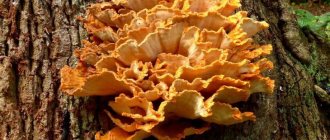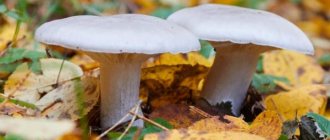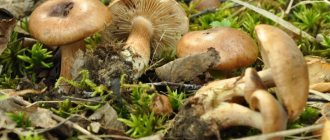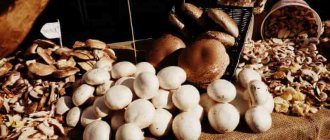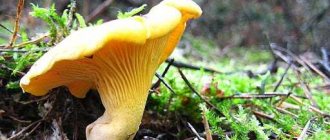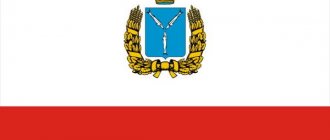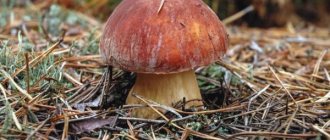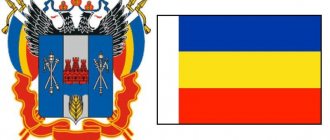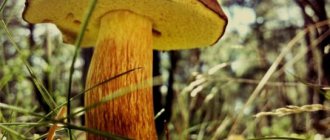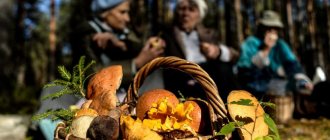Mushroom pickers know: in the forest you need to look not only at your feet. If you find a “lucky” stump, the basket will fill up faster. Mushrooms growing on stumps are edible.
Mushrooms that grow on a stump or dry dead wood act as forest health workers
Mushrooms that grow on a stump or dry dead wood perform the function of forest orderlies. They quickly destroy dead wood, accelerating the decay process, enriching the soil with useful minerals. There are many species of such organisms, but only a few are edible.
Gallery: edible mushrooms on tree stumps (25 photos)
Preparing to plant mycelium
To carry out the procedure for infecting a wood piece with a seed mixture, you will need a minimum amount of materials:
- Wooden log.
- Mycelium.
- Auxiliary equipment.
For the purpose of cultivation, you can select any type of low-grade wood. But it is better to prepare those varieties on which spores prefer to grow in natural conditions. Logs should not be older than 1-2 years. It is advisable to choose options with minimal signs of destruction, since fungi very aggressively wear out the tree and your growth medium will quickly exhaust its resource.
It is best to prepare wet and fairly fresh rock. The diameter of the blanks can vary from 15 to 30 cm. The optimal option is 20-25 cm. As was said, the most cost-effective family for home and industrial production is oyster mushroom. Mycelium of this genus is sold in several forms: various containers, plastic bags.
The main nuances that you should know about are the substrate on which the mycelium is grown. The main types include: cereal grains, sawdust, bars, corn cobs. There is an opinion that the most promising option is a seeding medium grown on grains. However, no significant differences in modifications of the bases were identified. Storage of the cultivation substrate should not exceed 6-7 months. Otherwise, the prospects for spore reproduction are reduced. It is better to plant fresh, healthy material.
The main requirements for storing mycelium include temperature (+2°C) and humidity. A high-quality planting substrate is a white conglomerate that is hard to the touch. If it is significantly changed, there will be no harvest. The extensive method involves the use of mycelial gruel or water, which can be easily poured into the seedling nests. The tools with which you will prepare logs for infection can be varied. It's best to have:
- drill;
- chainsaw;
- industrial film;
- metalworker's staple gun;
- container for sterilizing logs.
Types of mushrooms
Real, or autumn. The color can vary from light brown to brown with a reddish tint. Mushrooms growing on poplar or acacia stumps are light yellow, while those growing on pine or spruce are brown-red. The middle of the cap is covered with light scales, they are also called freckles. The thin stem always has a membranous light ring - this is the main difference between a real honey mushroom and a false one. Honey mushrooms are fried, salted, pickled, added to soups or pie fillings.
Tuberous. The hat is gray, the collar on the stem is thin. The freckles are located in the center, and the edges of the honey fungus are always smooth. In older specimens, the ring under the cap may disappear. They grow in deciduous forests.
Northern. These are mushrooms that are distinguished by an orange, honey or yellow hue. There is a white edge on the leg instead of a thin ring. These honey mushrooms grow on the stump in huge columns, often taking over nearby trees.
Also read: Serushka mushroom: description and beneficial properties
Thick-legged. The color is brown or brown. The leg is thick, the cap is convex, with rough scales. Mushrooms can be found on the stump of deciduous trees; they grow in small groups.
Dark. A thick mushroom of brown or dark brown color. It grows in coniferous forests; it grows extremely rarely on living trees, preferring stumps.
Inexperienced mushroom pickers often confuse false and edible specimens. But distinguishing them from each other is quite simple. It is enough to pay attention to some characteristics.
The main signs of poisonous mushrooms:
- absence of a ring (collar) under the hat;
- bright yellow or bright red color of the plates;
- smooth, thin legs narrowed to the base;
- in old specimens the plates are pale, often green;
- the taste is very bitter, but it is dangerous to try.
TOP 5 interesting facts about tree mushrooms
Edible species that parasitize plants are used in the preparation of salads and main dishes. They are pickled and salted, eaten stewed and fried, and added to snacks and delicacies in Korean and Chinese. Heat treatment is required before use. Energy value (calorie content) – 14-25 kcal.
Interesting facts worth noting:
- Crafts made from wood mushroom. From the hard pulp of some species they make figurines, jewelry (pendants, pendants), and make original lamps and lighting fixtures.
- Ability to bear fruit on wet sawdust, straw or cellulose. This feature allows you to grow some varieties in summer cottages.
- Increases with soaking. Tree mushrooms are small in size when dried, but when placed in water they expand several times in size.
- Taste of seafood. Species growing on trees differ in taste characteristics from classic mushrooms.
- Unique chemical composition. Many species have healing properties for the body and improve mental activity. They are used as part of low-calorie diets for weight loss, in the treatment of allergies, gastritis, oncology, diabetes and other diseases.
Useful types can be purchased in pharmacies in dry form. They are also included in a number of preparations for internal use and external application. In stores they are sold in pressed form (packaging briquettes).
Important! The benefits and harms of tree mushrooms depend on the correct method of preparation and compliance with contraindications. Store them dried in a cool, dry place to prevent the formation of mold.
Wild oyster mushrooms
The description of these large and very tasty mushrooms is familiar to novice lovers of quiet hunting more from trips to the store than from walks in the forest. The product is produced on an industrial scale for markets and supermarkets; many are grown in basements and garages. However, oyster mushrooms grow on stumps in the forest.
They produce the product on an industrial scale for markets and supermarkets, many grow them in basements and garages
There are several types of such mushrooms:
- Horn-shaped oyster mushroom. The cap is cream or white, the leg is curved, the plates extend almost to the edge of the leg. Grows in deciduous forests, prefers oak and rowan stumps.
- Orange. It grows in October-November only on rotten stumps in dead wood. It is frost-resistant, but the pulp is tasteless: it has a watery structure and a putrid odor. It is not poisonous; in some areas of central Russia, young specimens are eaten.
- Oyster, or ordinary. The most popular and delicious oyster mushrooms. Brown, dark gray, light olive. They grow densely. As they grow, the caps of these mushrooms become lighter. Very resistant to cold. They bear fruit even after the first frost.
- Pulmonary. Prefers coniferous forests. Outwardly similar to ordinary, but has more torn and smooth edges. The taste is bland, not very pronounced, and requires seasonings and spices when cooking.
Also read: Chaga mushroom: beneficial properties, use in folk and traditional medicine
Cultivation at home
Growing mushrooms at home on stumps is carried out for two purposes:
- Utilitarian: edibles are used for consumption. This is how entire mushroom plantations are grown in the basement or in the garden.
- Decorative: decorating fruit trees or gardens. People decorate their dachas with bright fruiting bodies: some types of tinder fungus are suitable for such purposes.
The search for suitable stumps is carried out in the forest or by cutting down dried trees. Some species take root equally well on all types of wood, while others are more demanding on the substrate. Growing on a large scale requires the following:
- Suitable place for sowing, high-quality mycelium.
- Temperature and light conditions.
- Regular treatment and replacement of stumps or other substrate. The fruiting bodies completely destroy the wood in 6-8 years.
If mushrooms are grown on your own plot, they will be tasty, environmentally friendly, and have healing properties.
Edible tinder fungi
Surely everyone has seen tinder fungi, huge as plates, in parks, forests and groves. But few people think about what kind of mushrooms are clinging to the trunks. Few people know that these organisms are edible and can be eaten.
Surely everyone has seen huge, saucer-like tinder fungi in parks, forests and groves
Polypores most often grow on living trees, but they can also often be seen on stumps.
- Variegated or woody mushroom. Collected from May to September, only young specimens are suitable for collection. It has a distinct taste and aroma.
- Sulfur yellow, or witch's dough. The large bright yellow caps look like huge overripe chanterelles. It is in the “test” stage, when the cap is still soft, that the mushroom is edible. Old individuals become woody and cannot be eaten. They grow on the stumps of deciduous trees. They prefer elm or oak.
Tiger Sawfoil
This is a wood-destroying species. If mushrooms grow on a living plant, it will soon collapse and die.
The description is similar to porcini mushrooms, which bear fruit in May. The color of the cap matches the color of the white champignon. Features of sawfoil:
- Its cap tapers downward, looks like an inverted umbrella, and merges with the stem.
- There is a depression in the middle of the cap, like chanterelles.
- The edges of the cap are wavy.
The synonymous “tiger” species was named because of its color: dark gray stripes stand out on white. The species does not have poisonous counterparts, but it itself has low nutritional value. The first specimens appear in May, fruiting ends in November.
It is recommended to eat only the boiled caps of young individuals, because their legs are somewhat harsh.
Volvariella, row and stag mushroom
A description of Volvariella is difficult to find even in some guides. This is because it is not popular among mushroom pickers in our country. In China, it is considered a delicious mushroom and is grown in special substrates. Three species of Volvariella grow in Russia, but only one is edible. This is Volvariella silky. Her hat is white, covered with light yellow fibers. Outwardly similar to a bell, in adult specimens it opens and becomes about 15 cm in diameter.
In China, it is considered a delicious mushroom and is grown in special substrates.
The red-yellow row looks like honey fungus. The color of the cap varies from pale pink to bright red, and the stem and plates are always yellow. This is a conditionally edible mushroom. It is not poisonous, but has poor taste and smells unpleasant when cooked. Some mushroom pickers advise pre-soaking the rows in cold salt water.
The cap of the deer mushroom is brown or gray-brown, the leg is long, white, the plates are pale pink. Grows in any type of forest, very drought-resistant. It is used for salting and pickling, and is pre-soaked.
Silent hunting is a favorite hobby of many Russians. To avoid unpleasant consequences, remember an important rule: if you’re not sure, don’t take it. If you have any doubts about whether the mushroom you find is edible, do not put it in the basket.
liverwort
These mushrooms on stumps have a somewhat frightening appearance. They are dense, bloody in color, and when cut, they resemble a piece of raw liver. The liverwort mycelium inhabits deciduous trees, mainly oaks or chestnuts. Only young mushrooms are suitable for harvesting; as they age, they harden and lose their taste. By the way, fried liverwort is slightly sour and turns out crispy.
Where to place the plantation?
The bars become overgrown in 2 – 2.5 months. After about this time, the first traces of young growth appear on them. This is a good sign. Now the logs can be installed in their permanent location. This is best done in a shaded garden. There they are buried to a depth of 10 cm. Now that your mushroom garden is ready, you need to periodically water it in very dry weather and harvest.
